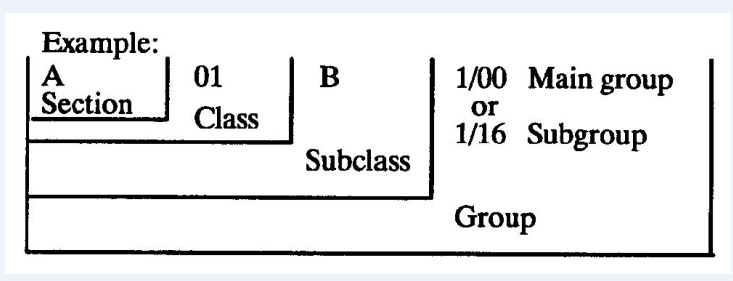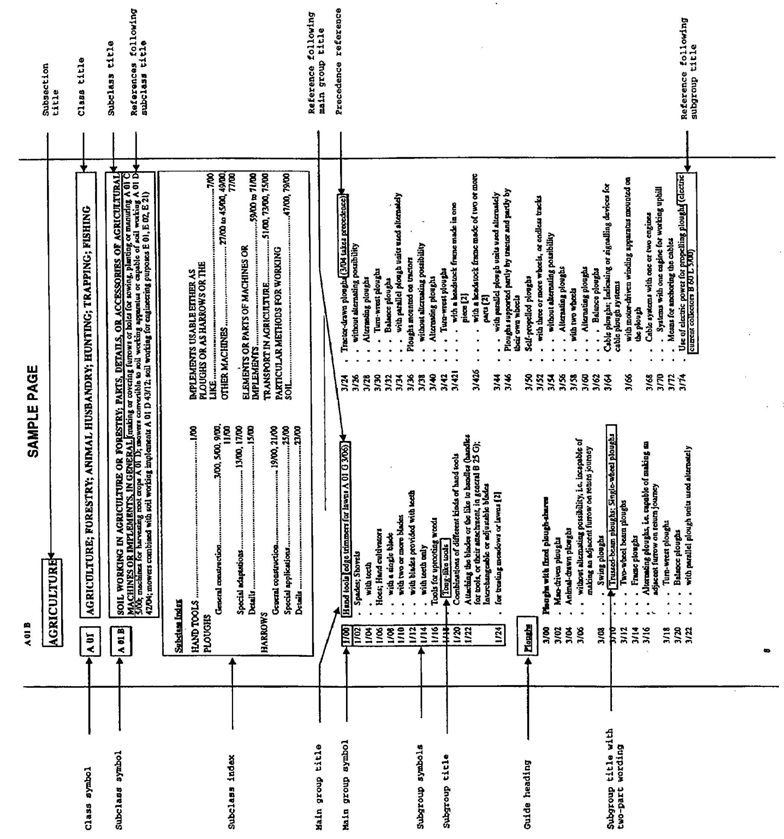906 International Classification of Patents for Inventions [R-07.2015]
In accordance with the Strasbourg Agreement Concerning the International Patent Classification, the United States is required to indicate on its issuing documents the classification symbols of the International Patent Classification 2006 (Eighth Edition), hereinafter referred to as “Int. Cl.”
The complete Int. Cl. symbols must be placed in the indicated space on the Image File Wrapper (IFW) issue classification form when an application is issued.
I. INT. Cl. LAYOUTThe layout of the Int.Cl. is explained below with reference to the sample page.
A.SectionThe Classification represents the whole body of knowledge which may be regarded as proper to the field of patents for invention, divided into eight sections.
(A)Section Symbol — Each section is designated by one of the capital letters A through H.
(B)Section Title — The section title is to be considered as a very broad indication of the contents of the section. The eight sections are entitled as follows:
- A. Human Necessities
- B. Performing Operations; Transporting
- C. Chemistry; Metallurgy
- D. Textiles; Paper
- E. Fixed Constructions
- F. Mechanical Engineering; Lighting; Heating; Weapons; Blasting
- G. Physics
- H. Electricity
Contents of Section — Each section title is followed by a summary of the titles of its main subdivisions.
(D)Subsection — Within sections, informative headings form subsections, which are titles without classification symbols.
Example: Agriculture
B.ClassEach section is subdivided into classes.
(A)Class Symbol — Each class symbol consists of the section symbol followed by a two-digit number.
Example: A 01
(B)Class Title — The class title gives an indication of the content of the class.
Example: A 01 Agriculture; Forestry; Animal Husbandry; Hunting; Trapping; Fishing
C.SubclassEach class comprises one or more subclasses.
(A)Subclass Symbol — Each subclass symbol consists of the class symbol followed by a capital letter.
Example: A 01 B
(B)Subclass Title — The subclass title indicates as precisely as possible the content of the subclass.
Example: A 01 B Soil Working in Agriculture or Forestry; Parts, Details, or Accessories of Agricultural Machines or Implements, in General
(C)Subclass Index — Some subclasses have an index which is merely an informative summary giving a broad survey of the content of the subclass.
D.GroupEach subclass is broken down into subdivisions referred to as “groups,” which are either main groups or subgroups.
(A)Group Symbol — Each group symbol consists of the subclass symbol followed by two numbers separated by an oblique stroke.
(B)Main Group Symbol — Each main group symbol consists of the subclass symbol followed by a one- to three-digit number, the oblique stroke, and the number 00.
Example: A 01 B 1/00
(C)Main Group Title — The main group title defines a field of subject matter considered to be useful in searching for inventions.
Example: A 01 B 1/00 Hand tools
(D)Subgroup Symbol — Subgroups form subdivisions under the main groups. Each subgroup symbol consists of the subclass symbol followed by the one- to three-digit number of its main group, the oblique stroke, and a number of at least two digits other than 00.
Example: A 01 B 1/02
Any third or fourth digit after the oblique stroke is to be read as a decimal subdivision of the second or third digit, respectively; e.g. 3/426 is to be read as “three slash forty-two point six”, not three slash four hundred and twenty six and is to be found after 3/42 and before 3/43, and 5/1185 is to be read as “five slash eleven point eight five,” and is to be found after 5/118 and before 5/119.
(E)Subgroup Title — The subgroup title defines a field of subject matter within the scope of its main group considered to be useful in searching for inventions. The title is preceded by one or more dots indicating the hierarchical position of the subgroup, i.e., indicating that each subgroup forms a subdivision of the nearest group above it having one dot less. The subgroup title is often a complete expression, in which case it begins with a capital letter. A subgroup title begins with a lower case letter if it reads as a continuation of the title of the next higher, less-indented group, i.e., having one dot less. In all cases, the subgroup title must be read as being dependent upon, and restricted by, the title of the group under which it is indented.
Examples
A 01 B 1/00 1/24 Hand tools for treating meadows or lawns (The title of 1/24 is to be read as:
Hand tools for treating meadows or lawns.)
A 01 B 1/00 1/16 Hand tools Tools for uprooting weeds (The title of 1/16 is a complete expression, but owing to its hierarchical position, the tools for uprooting weeds are restricted to hand tools.)
E.Complete Classification SymbolA complete classification symbol comprises the combined symbols representing the section, class, subclass, and main group or subgroup.

Guide Headings
The main groups in each subclass are arranged in a sequence intended to assist the user. It has not, however, been found practicable to standardize the sequence. Where several successive main groups relate to common subject matter, it is usual to provide before the first of such main groups a “guide heading” which is underlined, indicating this subject matter (see, for example, the guide heading “Ploughs” before group A 01 B 3/00). The series of groups covered by such a heading extends to the next guide heading or to a line in heavy type extending across the column, which is used when the following group or groups relate to different subject matter for which no guide heading is provided. (See, for example, the line after A 01 B 75/00.)
II. CLASSIFYING IN THE INT. Cl. SYSTEMA.Selecting Subclasses Corresponding to U.S. ClassesThe effective scope of a subclass is defined by the following, taken together:
(A)The subclass title which describes, as precisely as is possible in a small number of words, the main characteristic of a portion of the whole body of knowledge covered by the Classification, this portion being the field of the subclass to which all its groups relate;
(B)Any references which follow the subclass title or the hierarchically higher class title. These references often indicate certain parts of the field described by the title which are covered by other subclasses and are, therefore, excluded. These parts may constitute a substantial part of the field described by the title and, thus, the references are in some respects as important as the title itself. For example, in subclass A 47 D — FURNITURE SPECIALLY ADAPTED FOR CHILDREN — a considerable part, namely school benches or desks, of the subject matter covered by the title is excluded in view of a reference to particular groups of subclass A 47 B, thus considerably altering the scope of subclass A 47 D;
(C)Any references which appear in groups or guide headings of a subclass and which refer subject matter to another class or subclass may also affect the scope of the subclass in question. For example, in subclass B 43 K — INSTRUMENTS FOR WRITING; DRAWING-PENS — writing points for indicating or recording apparatus are referred out of group 1/00 to group 15/16 of subclass G 01 D, thereby reducing the scope of the subject matter covered by the title of subclass B 43 K;
(D)Any notes or definitions appearing under the subclass title or its class, subsection, or section title. Such notes or definitions may define terms or expressions used in the title, or elsewhere, or clarify the relation between the subclass and other places. Examples are
- (1) Note (1) appearing under the title of the subsection “ENGINES OR PUMPS,” embracing classes F 01 to F 04, which notes define the terms used throughout the subsection,
- (2) the notes appearing under the title of subclass F 01 B, which define its scope in relation to subclasses F 01 C to F 01 P, and
- (3) the note following the title of section C which defines groups of elements.
The scope of a main group is to be interpreted only within the effective scope of its subclass (as indicated above). Subject to this, the effective scope of a main group is determined by its title as modified by any relevant references or notes associated with the main group or with any guide heading covering it. For example, a group for “bearings” in a subclass whose title is limited to a particular apparatus must be read as covering only features of bearings peculiar to that apparatus, e.g., the arrangement of bearings in the apparatus. Guide headings are intended to be only informative and, as a rule, do not modify the scope of the groups covered by them, except where it is, otherwise, clear from the context. By contrast, references in the guide headings modify the scope of the associated groups.
C.Selecting Subgroups Corresponding to U.S. Indented SubclassesThe scope of a subgroup is likewise to be interpreted only within the effective scope of its main group and of any subgroup under which it is indented. Subject to this, the scope of a subgroup is determined by its title as modified by any relevant references or notes associated therewith.
See volume 9 of the International Patent Classification, entitled “Guide, Survey of Classes and Summary of Main Groups” for detailed procedures for classifying into and searching Int. Cl.

The Office of Patent Classification has prepared a revised Concordance between the U.S. classes and subclasses and the Int. Cl. In many areas, the two systems are conceptually different. With this in mind, it will be seen that a complete one-to-one correspondence between the two systems cannot be attained. An indication in the Concordance may refer to only one relevant group and not necessarily the only group in which the patent can or should be classified. For some inventions, the Concordance may not indicate any truly relevant group. Accordingly, the Concordance must be recognized as a guide to be used in conjunction with the Int. Cl., and not as a translation list.

